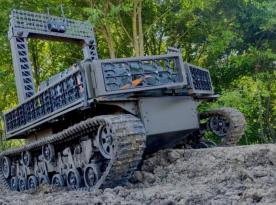A civilian ship carrying Ukrainian grain has suffered an attack by russian armed forces in the neutral waters of the Black Sea. The incident that took place on the night of September 12th and its consequences were reported by President of Ukraine Volodymyr Zelenskyi via social media.
Zelenskyi attached photos of the vessel after the hit, the name or type of which remain undisclosed. The ship stayed afloat and the crew suffered no casualties.
Read more: Ukrainian Special Forces Destroy russian Su-30SM Fighter in the Black Sea Using MANPADS (Video)
Russian missile against a wheat cargo bound for Egypt. Tonight, Russia launched a strike on an ordinary civilian vessel in the Black Sea right after it left Ukrainian territorial waters. Fortunately, there were no casualties, according to preliminary reports.Ukraine is one of… pic.twitter.com/nNCqNDVfJV — Volodymyr Zelenskyy / Володимир Зеленський (@ZelenskyyUa) September 12, 2024
Scattered pieces of information published by unofficial sources allowed Defense Express to trace back the events. First off, the vanek_nikolaev Telegram channel claims that the strike was inflicted by a Kh-22 cruise missile.

There's also valuable insight from specialized air threat monitoring communities that were tracking the movements of russian military aviation in real time on the evening of September 11th. At 23:05, several Tu-22M3 strategic bomber aircraft were spotted flying westward to the weapon release points near Crimea, then launched missiles towards either Zmiinyi (Snake) Island or the southern part of the Odesa Region of Ukraine. Following the launches, the bombers turned around and headed in the opposite direction.
Пуск Х-22 у напрямку Півдня Одещини/ о. Зміїний.23:06 — monitor (@war_monitor_ua) September 11, 2024
As for the vessel that came under attack, the Portovik channel on Telegram reported that it was the Aya bulk carrier sailing under the flag of Saint Kitts and Nevis. According to the Marinetraffic service the ship had departed from the port of Chornomorsk, Ukraine.
The service gives the opportunity to reconstruct its route, revealing that on September 11, at 23:19, this vessel was approximately 50 km from the Romanian coast and abruptly changed its course. This quite clearly coincides with the time and reported direction of the Kh-22 missile launched by the russian Tu-22M3.

To understand the broader picture, it is crucial to recall how exactly the Kh-22 missile launch happens in general. First of all, the Kh-22 is an anti-ship missile, not a land attack weapon for indiscriminate attacks on cities — in our case, the Ukrainian cities. In order to initiate the launch, the weapons operator on Tu-22M3 must use his on-board radar to find a target (a ship, usually), wait until the missile's active radar homing head locks on the target, and only after these procedures, he can pull the trigger.
Now, let's take a look at what's the commonplace situation in the water area where the Aya vessel was seen at the time of the strike. For the reference, take the situation as of writing this article, 19:00 local time:

A total of eight tankers (marked in red) are present. If any of these gets destroyed by a wandering or even deliberately targeted missile, the potential large-scale oil spill could lead to an environmental disaster, affecting primarily the Black Sea areas adjacent to the coasts of Romania and Ukraine. The risk is especially high, considering that anti-ship missiles have a feature to independently reassign their target to a larger one.
In other words, even if the russian airman commands the missile to attack a bulk carrier, there are no guarantees that the Kh-22 will not choose to strike a larger tanker instead. That is not to mention the limited capabilities for precise target identification and selection from the board of the russian Tu-22M3 in the first place. The real intentions behind russia's attack with anti-ship missiles in a region frequented by civilian vessels is an open question, too.
Read more: It Became Known Where russians Store Their Kh-22 Missiles














